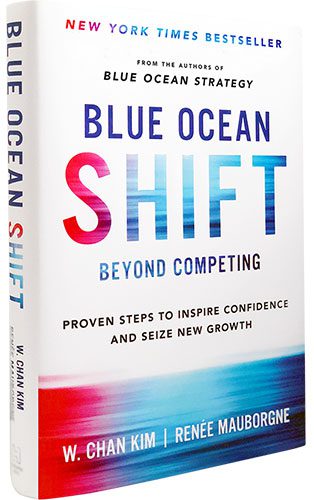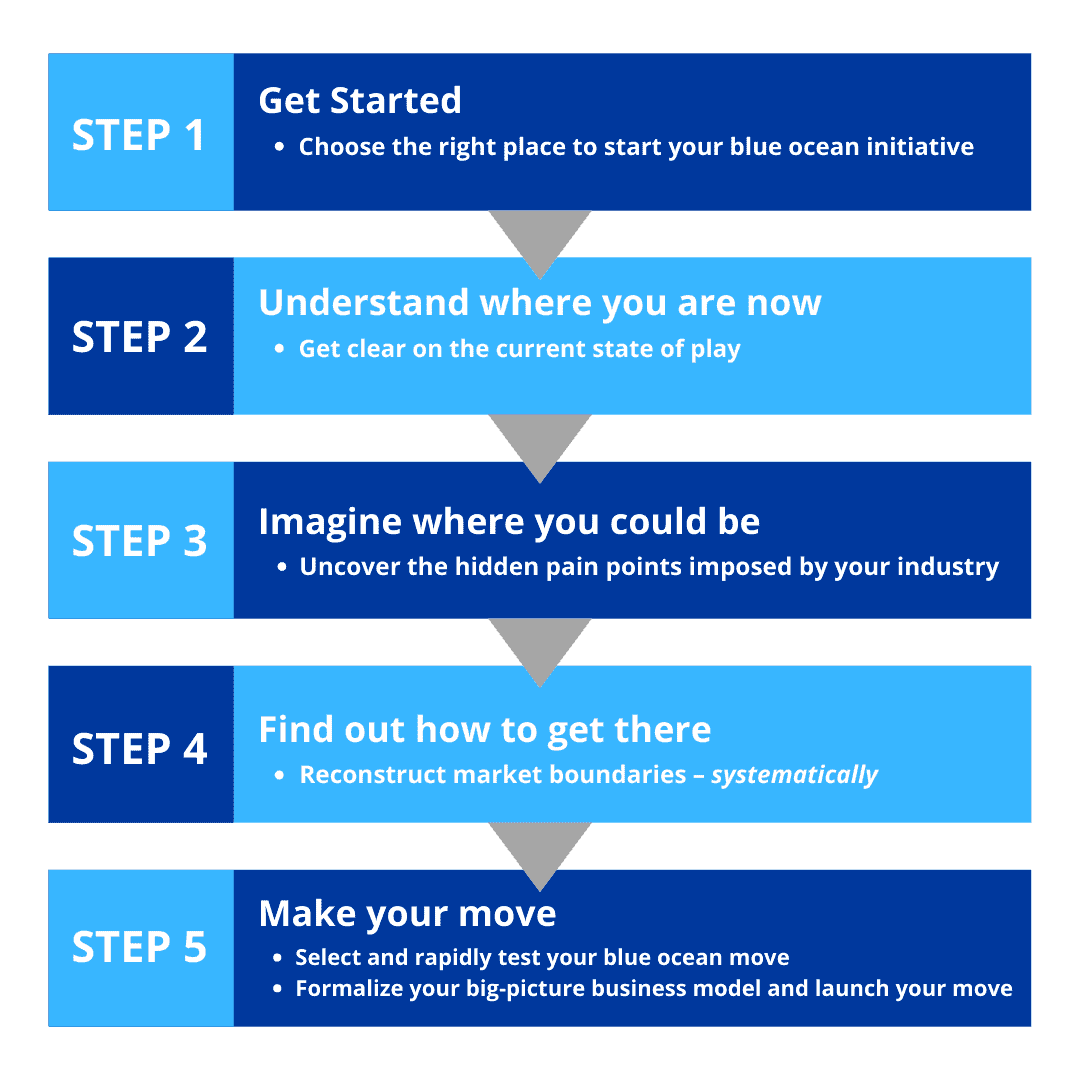BLUE OCEAN SHIFT QUESTION & ANSWER
Chan Kim and Renée Mauborgne, the authors of Blue Ocean Strategy & Blue Ocean Shift, answer some of the most common questions they receive on blue ocean shift from around the world. We hope these will be of interest to you too!

Questions About Blue Ocean Shift
What is Blue Ocean Shift?
Whether you are a cash-strapped start-up or large, established company, non-profit or national government, you can SHIFT from cutthroat markets – red oceans – to wide-open new markets – or blue oceans of uncontested market space – by following a simple five-step process that brings your people along so they own and drive the process.
Why did you write blue ocean shift?
Chan Kim & Renée Mauborgne: Blue Ocean Shift addresses a key challenge facing virtually every organization today. How to move yourself, your team, and your organization from competing to creating. Or, from cutthroat markets to wide-open new markets in a way your people own and drive the process.
Think about it. What industry today doesn’t face intense competition? Take retail. It’s getting decimated. The competition is fierce. It’s tough. It’s rough. It’s what we refer to as a bloody red ocean.
But the successful companies aren’t in those red oceans. They’re moving into and creating new markets. What we think of as blue oceans.
The question is: How can all of us do that too?
This book lays out the path anyone can follow to get there, using proven steps.

How does blue ocean shift build upon and go beyond blue ocean strategy?
Chan Kim & Renée Mauborgne: A decade ago we wrote our first book Blue Ocean Strategy, which went on to sell over 3.6 million copies and become a bestseller on five continents. As the tidal wave of interest grew, individuals, governments, companies, and nonprofits started to look at their world through the lens of red and blue oceans. Suddenly people the world over were identifying themselves as in a red ocean with a call to action to get out and create blue oceans.
This raised the conversation and questions to a whole new level: from “what is blue ocean strategy?” to “how can I shift my organization from red to blue oceans?” Established companies were unsure of how to start the process of moving to blue waters, which would often require getting the members of their team to buy into a concept that directly conflicted with the long-established rules of their industries. Entrepreneurs were looking for concrete steps and a systematic process they could follow to create and capture blue oceans at minimal risk.
Hence, what people were keenly interested to understand were the dynamics of actual transformation. What does it take to change, to move an organization – be it corporate, an upstart, a non-profit, or even a government from the red ocean to the blue. Achieving that requires a shift. Not just in strategy. But also in mindset and culture.
To address this challenge head-on we spent the last decade analyzing and comparing the successes and failures of blue ocean projects across the globe that have sprung out of the movement we began to go beyond competing and shift out of red oceans. Analyzing a variety of sectors from business-to-customer and business-to-business, to public, nonprofit, and governments – including what worked and what didn’t – we developed a concise understanding of the process of new market creation and growth that unlocks people’s creativity as much as their confidence to act. Blue Ocean Shift is the result. If our first book is the What, Blue Ocean Shift is the How.

What are the key lessons of blue ocean shift?
Chan Kim & Renée Mauborgne: You need two things to shift. Without them you are going to struggle.
First lesson is that you don’t have to be born Steve Jobs or be a startup to make a blue ocean shift. People are quick to discount the possibility that they or their organization could shift from red to blue oceans. But they shouldn’t. As our research over the last ten years bears out, with a clear roadmap and easy-to-use tools making a blue ocean shift becomes possible for organizations of every stripe, allowing them to reach new heights of market creation and growth. Blue Ocean Shift is brimming with real-world examples of companies large and small, old and new, for-profit and nonprofit and even a national government that faced the same types of organizational and bureaucratic hurdles we all face – be they resource, political, or motivational and yet overcame them to shift from red to blue by applying the very process and tools outlined in the book. It’s not about an entrepreneur’s trial and error, anyone can create a blue ocean.
Second is the importance of recognizing our humanness to make change happen. People are paradoxical. We aspire to make a difference. We want to change the world for the better. That’s what makes our energies sore and our hearts beat faster, our adrenaline surge. Yet, simultaneously, most of us fear we can’t. We need reassurance. Blue ocean shift recognizes that we all are replete with creative energy and resilience, at our core, most of us are also incredibly tender and vulnerable. To suspend belief in the limits of today so we can see and create new possibilities and new pathways to growth, we need to inspire confidence in ourselves and our people.
Without the confidence to act, few will venture down a new path, no matter how clear the roadmap. In Blue Ocean Shift, inspiring people’s confidence is put on an equal plane with a tested process and market-creating tools to move you, your team, and your organization from red to blue oceans in a way that people own and drive the process. Humanness, not carrots and sticks, is the key to inspiring and building people’s confidence to succeed. It builds psychological understanding into the strategic process so that people are willing to engage fully at every step – even when they are hesitant, may not trust one another, or are skeptical of their ability to succeed on the transformation journey.
What are the five steps to making a blue ocean shift?
Chan Kim & Renée Mauborgne: Ninety percent of businesses fail within ten years. In almost any other context, that would be a shocking statistic. But it’s something the entrepreneurial community seems to accept as standard.
If you want to minimize the randomness and trial and error in creating new market space, follow these five systematic steps so that you maximize the chances of hitting the bullseye.

How is a blue ocean strategist different from a red ocean strategist?
Chan Kim & Renée Mauborgne: There are four defining characteristics that separate the mind of a blue ocean strategist from a red ocean one. They determine the questions you ask and what you see and don’t see, which makes your perspective important. The four characteristics revolve around the assumptions people make regarding industry structure, competition, customers, and value and cost. Let’s zoom in on one, industry conditions, to show you how these two perspectives differ and play out.
When executives develop strategy, they nearly always begin by analyzing the environment: Is the industry growing, stagnant, or shrinking? Are raw material prices rising or falling? Are competitors building new plants, launching major new product lines, laying off hundreds, or hiring new talent? And so on. This view of strategy is deterministic in that: (1) it treats an organization’s strategic options as limited by the environment; and (2) it bounds executives’ imaginations by the industry’s current conditions.
That’s the mindset of a red ocean strategist. This mindset keeps your strategy anchored in the existing industry conditions.
A blue ocean strategist, by contrast, does not take industry conditions as given. Rather they set out to reshape them in their favor. What a blue ocean strategist recognizes, and most of us often forget, is that while industry conditions exist, individual firms created them. And just as individual firms created them, individual firms can shape them too. They are as fluid as our imaginations. Blue ocean strategists, therefore, ask fundamentally different sets of questions that enable them to challenge long-held assumptions and artificial boundaries that red ocean strategists may unknowingly be imposing upon themselves. In that sense, adopting the perspective of the blue ocean strategist is like looking up at the night sky at the single constellation your industry has long been focused on and then turning your head to see the vast expanse of the universe that hadn’t been in your field of vision before. It expands your horizons and shifts your understanding of where opportunity resides.
Blue Ocean Shift explains the other three characteristics that revolve around the assumptions people make regarding competition, customers, and value and cost, and shows how they separate the mind of a blue ocean strategist from a red ocean one.

What is nondisruptive creation?
Chan Kim & Renée Mauborgne: Nondisruptive creation is where one’s gain doesn’t have to come at the expense of others. Very often entrepreneurs associate market creation with disruption or creative destruction, focusing on displacing existing players and markets by bringing in a superior product. However, our research shows that many new markets have been created without disrupting existing ones.

What is “humanness”? Why is it a key component to making a successful blue ocean shift?
Chan Kim & Renée Mauborgne: Humanness is having a humanistic process in your organization. It’s a topic we explore in detail in Blue Ocean Shift.

What’s the difference between creating new market space, or blue oceans, and disruption?
Chan Kim & Renée Mauborgne: Disruption matters. But as our research reveals, that’s only half the picture of how new markets and blue oceans are created. The other half, and we would argue the more important half of how new markets and blue oceans are created, is what we call nondisruptive creation. What we mean by that is creating new markets where there once wasn’t any.
Take one of the many examples in our research, microfinance. Today it’s a multibillion-dollar industry. But twenty-five years ago it didn’t exist. That market didn’t exist until Grameen Bank solved an unaddressed problem: the lack of access to capital for billions of people who lived on only a few dollars a day. Microfinance didn’t disrupt anything.
No one lost a job because of it. No company went out of business. It only enabled people who had previously been denied access to capital to now start businesses and change the quality of their lives. Viagra, online dating, Sesame Street, life-coaching – are other examples of new markets that were created with nondisruptive creation. And as we lay out in Blue Ocean Shift, the opportunities for nondisruptive creation are huge.
No executive or entrepreneur can afford to not understand this missing half of how new markets are created. That would be like shutting yourself from half of your opportunities to seize new growth. Our book Blue Ocean Shift shows how new market space is created based on both disruption and nondisruptive creation and outlines the path to achieve one over the other.

Are entrepreneurs the only ones capable of creating new markets?
Chan Kim & Renée Mauborgne: Market creation can be achieved through a reliable and systematic process by anyone, not just entrepreneurs.
Conventionally, market creation has often been seen as the result of a trial-and-error process and the domain of entrepreneurs with certain traits like animal instinct and persistency. While the notion of entrepreneurship was known earlier, the economist Joseph Schumpeter, who is known for his concept of “creative destruction”, has had a key influence in shaping this conventional view. Schumpeter saw entrepreneurs as the chief drivers of innovation and therefore market creation. His argument is that entrepreneurs take risks and learn through trial and error as they attempt to seize opportunities by applying their intuition and ingenuity.

What should all young, first-time entrepreneurs know before they start a business?
Chan Kim & Renée Mauborgne: The first thing every entrepreneur or small business owner needs to know is that if they want to grow and scale, they need to move away from competing. Instead they should move into and create new markets. They don’t need to go against established players with many times the financial and marketing resources. We’ve seen how small companies can grow very fast and quickly become big by not going head-to-head but by creating. Why go against Goliath when you don’t have to?
Take citizenM Hotels. A company founded in 2008 that by applying the tools and process outlined in Blue Ocean Shift sidestepped the intense competition of the hotel industry and created the new market of affordable luxury hotels. Five-star comfort at prices accessible to three star customers. Who wouldn’t like that? No wonder they have guest ratings in the superb and fabulous category and occupancy rates 80% higher than the industry average. And they did that while eliminating almost 40% of what the industry competes on, making them arguably one of the most profitable hotel chains in the world. Today they are rolling out to major cities across the world.
That’s the real opportunity we see for startups and small companies to grow and scale. To shift from competing to creating and fueling growth by offering unprecedented value.
Where should a startup start their blue ocean shift process?
Chan Kim & Renée Mauborgne: For a startup, the first step should be to have a clear understanding of where you stand. To do this, you should draw your as-is strategy canvas that will give you and your team a big picture view of the current state of play in your target industry.
It will let you clearly see the industry’s defining contours without getting lost in the small operational details. By drawing the strategy canvas, you would have captured on a single page the current state of play, the assumptions the industry acts on that you can later overturn, as well as the degree of competitive convergence across the existing players. This gives the team a commonly agreed-upon baseline to assess new ideas against.
The next step is to “imagine where you could be,” which is all about identifying the total demand landscape beyond the existing industry that you can unlock – these are current noncustomers – and a big big-picture view of the ways in which the underlying assumptions and boundaries that currently define the industry also limit its appeal and size. Here you will use tools such as the buyer utility map and the three tiers of noncustomers to identify real opportunities that you could unlock to make a blue ocean shift. These are the first steps to get you started as we lay out in the book.
Read next: “5 Compelling Strategy Canvas Examples You Can Learn From.”
What’s different between blue ocean shift and the other strategy books out there? Does it bring anything new to the table?
Chan Kim & Renée Mauborgne: Most strategy books are focused on how to compete. But our research shows the future is on how to create. And what we have been lacking is a roadmap to get there with tools and guidance anyone can apply.
Secondly, most books either lack analytic tools and frameworks or they are soft on people. But you need both to shift and move an organization in any transformation. We need to have a clear roadmap of how to get there and we need to bring people along and build their confidence to act. And that is what our new book Blue Ocean Shift does. It brings these two dimensions together so that no matter what organization you are sitting in you can start to make the shift.
